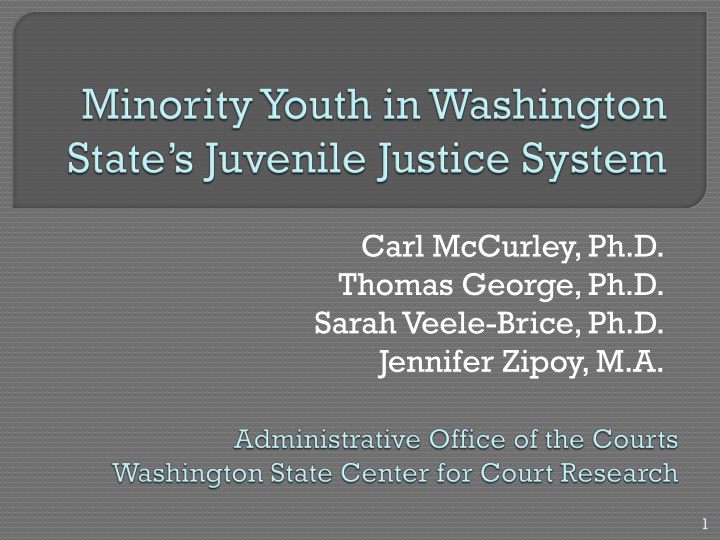
Main Decision Points in the Juvenile Justice System and Demographic Disparities
Explore the main decision points in the juvenile justice system and the disparities among different demographic groups. This analysis includes data on arrests, referrals to court, diversion rates, prosecutions, guilty adjudications, and confinement in state facilities over time. Gain insights into the involvement of African-American, Native American, Asian/Pacific Islander, and Latino youth in the juvenile justice system.
Download Presentation

Please find below an Image/Link to download the presentation.
The content on the website is provided AS IS for your information and personal use only. It may not be sold, licensed, or shared on other websites without obtaining consent from the author. If you encounter any issues during the download, it is possible that the publisher has removed the file from their server.
You are allowed to download the files provided on this website for personal or commercial use, subject to the condition that they are used lawfully. All files are the property of their respective owners.
The content on the website is provided AS IS for your information and personal use only. It may not be sold, licensed, or shared on other websites without obtaining consent from the author.
E N D
Presentation Transcript
Carl McCurley, Ph.D. Thomas George, Ph.D. Sarah Veele-Brice, Ph.D. Jennifer Zipoy, M.A. 1
Main Decision Points in the Juvenile Justice System Diversion All youth age 10 to 17 Referral to Court Arrest Probation Petition (charges filed) Adjudication JRA Law (Supervision) Enforcement Juvenile Court Population RRIs are calculated for each decision point 2
White Black Latino Asian AI / AN 3% 2% 5% 7% 15% 20% 6% 51% 70% 21% Washington State Juvenile Population Washington State Youth Sentenced to JRA 3
White Black Latino Asian AI / AN 2% 2% 2% 7% 15% 26% 38% 6% 70% 31% Washington State Juvenile Population Cases Transferred to Adult Court 4
1992 vs. 2009 African- American Native American Asian/ Pacific Islander Latino 1992 2009 1992 2009 1992 2009 1992 2009 Arrest 1.7 1.8 1.0 1.3 0.4 0.3 0.7 N/A Referred to court 4.9 2.7 1.4 2.1 0.9 0.5 1.1 1.4 Diverted 0.6 1.6 0.8 1.3 0.9 0.6 0.1 1.2 Prosecuted 3.3 3.8 1.3 2.5 0.6 0.6 1.1 1.7 Adjudicated guilty 2.6 3.7 1.2 2.4 0.6 0.6 1.1 1.8 Confined in state facility 7.1 5.2 2.8 2.5 0.7 0.9 1.9 1.7 5
1992 vs. 2009 African- American Native American Asian/ Pacific Islander Latino 1992 2009 1992 2009 1992 2009 1992 2009 Arrest 1.7 1.8 1.0 1.3 0.4 0.3 0.7 N/A Referred to court 4.9 2.7 1.4 2.1 0.9 0.5 1.1 1.4 Diverted 0.6 1.6 0.8 1.3 0.9 0.6 0.1 1.2 Prosecuted 3.3 3.8 1.3 2.5 0.6 0.6 1.1 1.7 Adjudicated guilty 2.6 3.7 1.2 2.4 0.6 0.6 1.1 1.8 Confined in state facility 7.1 5.2 2.8 2.5 0.7 0.9 1.9 1.7 6
1992 vs. 2009 African- American Native American Asian/ Pacific Islander Latino 1992 2009 1992 2009 1992 2009 1992 2009 Arrest 1.7 1.8 1.0 1.3 0.4 0.3 0.7 N/A Referred to court 4.9 2.7 1.4 2.1 0.9 0.5 1.1 1.4 Diverted 0.6 1.6 0.8 1.3 0.9 0.6 0.1 1.2 Prosecuted 3.3 3.8 1.3 2.5 0.6 0.6 1.1 1.7 Adjudicated guilty 2.6 3.7 1.2 2.4 0.6 0.6 1.1 1.8 Confined in state facility 7.1 5.2 2.8 2.5 0.7 0.9 1.9 1.7 7
1992 vs. 2009 African- American Native American Asian/ Pacific Islander Latino 1992 2009 1992 2009 1992 2009 1992 2009 Arrest 1.7 1.8 1.0 1.3 0.4 0.3 0.7 N/A Referred to court 4.9 2.7 1.4 2.1 0.9 0.5 1.1 1.4 Diverted 0.6 1.6 0.8 1.3 0.9 0.6 0.1 1.2 Prosecuted 3.3 3.8 1.3 2.5 0.6 0.6 1.1 1.7 Adjudicated guilty 2.6 3.7 1.2 2.4 0.6 0.6 1.1 1.8 Confined in state facility 7.1 5.2 2.8 2.5 0.7 0.9 1.9 1.7 8
What is a Relative Rate Index (RRI)? Numberof Minority Contacts Rate of Minority Contact Relative Rate Index Minority Population Numberof White Contacts Rate of White Contact White Population 1 Lesser Chance of Contact Greater Chance of Contact 9
American Indian / Alaska Native, non-Hispanic 1.3 Asian or Pacific Islander, non-Hispanic 0.32 Hispanic (NO DATA) Black, 1.85 non-Hispanic 0 0.2 0.4 0.6 0.8 1 1.2 1.4 1.6 1.8 2 White 10
American Indian / Alaska Native, non-Hispanic 2.14 Asian or Pacific Islander, non-Hispanic 0.5 1.29 Hispanic Black, 2.58 non-Hispanic 0 0.5 1 1.5 2 2.5 3 White 11
American Indian / Alaska Native, non-Hispanic 0.62 Asian or Pacific Islander, non-Hispanic 1.07 0.85 Hispanic Black, 0.61 non-Hispanic White 0 0.2 0.4 0.6 0.8 1 1.2 1.4 1.6 1.8 2 12
American Indian / Alaska Native, non-Hispanic 1.19 Asian or Pacific Islander, non-Hispanic 1.06 1.21 Hispanic Black, 1.42 non-Hispanic White 0 0.2 0.4 0.6 0.8 1 1.2 1.4 1.6 1.8 2 13
American Indian / Alaska Native, non-Hispanic 0.98 Asian or Pacific Islander, non-Hispanic 0.95 1.05 Hispanic Black, 0.97 non-Hispanic White 0 0.2 0.4 0.6 0.8 1 1.2 1.4 1.6 1.8 2 14
American Indian / Alaska Native, non-Hispanic 0.94 Asian or Pacific Islander, non-Hispanic 1.62 1.02 Hispanic Black, 1.38 non-Hispanic White 0 0.2 0.4 0.6 0.8 1 1.2 1.4 1.6 1.8 2 15
Differences in Overlap by Race & Ethnicity 16
100% CA accepted referral, truancy petition, & delinquency referral 90% CA accepted referral & delinquency referral 80% Truancy petition & delinquency referral 70% 60% 34% 50% 20% 15% 16% 40% 9% 13% 30% 26% 23% 11% 17% 20% 26% 19% 10% 16% 16% 15% 0% American Indian/ Alaska Native Black Hispanic White Asian/ Pacific Islander 18
